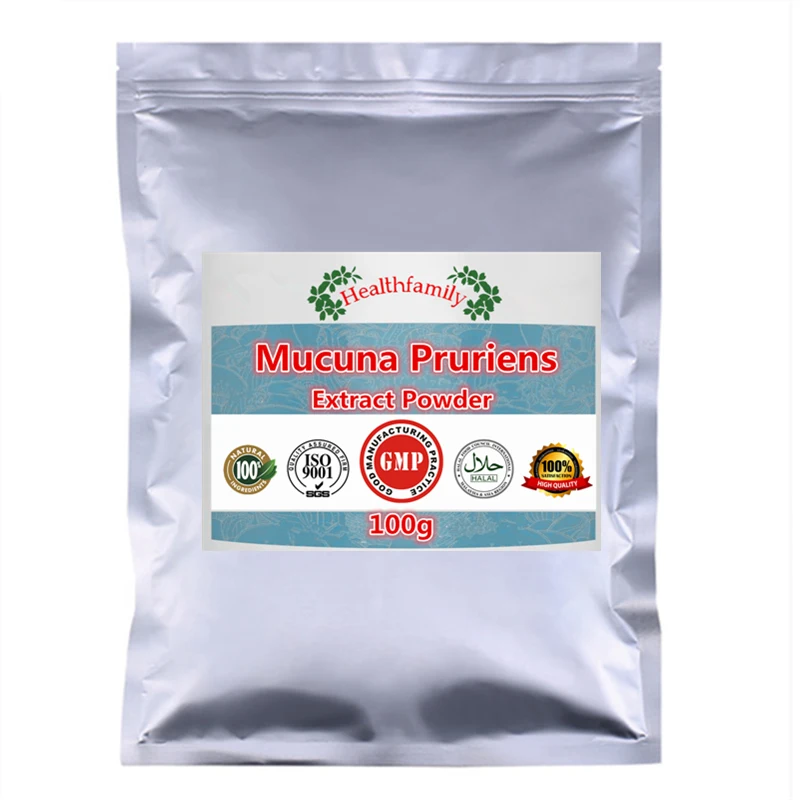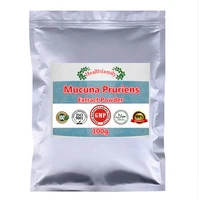Free shipping
HISTORY OF L-DOPA
The Mucuna Pruriens (Velvet Bean) plant grows natively in the Caribbean, and some parts of India and Africa. It thrives in tropical-like conditions, growing to 15 meters high. The plant bears seeds or beans which contain the bulk of its L-Dopa, as much as 100 micrograms per seed. These seeds have been harvested for centuries and used as folk medicinals for a variety of ailments including muscle pain, dysentery, sexual dysfunctionand more… Mucuna pruriens (Velvet Bean), a tropical legume also known as velvet bean, has been used by ancient healers. Herbal medicine has relied on Mucuna pruriens (Velvet Bean) since 1500 BC to support ailments such as snakebite, intestinal disorders, sexual response, melancholy mood and stress management. Mucuna pruriens, (also known as Levodopa, or L-dopa), is one of compounds. Mucuna pruriens has significant antioxidant action that works in tandem with L-dopa to promote brain health. L-DOPA is 99% extract from plant Mucuna Pruriens. This bioactive chemical is a precursor to several neurotransmitters, including adrenaline, noradrenaline, and dopamine. L-dopa has been used for thousands of years. An ancient civilisation in India used a tropical legume called Mucuna Pruriens, whose seeds are a natural source of therapeutic quantities of L-dopa. Vicia faba, also known as the broad bean, fava bean, faba bean, field bean, bell bean, or tic bean, is a species of flowering plant in the pea and bean family Fabaceae. It is native to North Africa, southwest and south Asia, and extensively cultivated elsewhere. The faba, or broad bean, is a staple crop in this regions because of its high protein content of 20 to 25%.
WHAT IS L-DOPA?
L-Dopa was first isolated from seedlings of Vicia faba by Marcus Guggenheim in 1913. Guggenheim suspected that L-dopa was a precursor to adrenaline. Beginning in 1927, biochemists discovered that L-dopa was biologically active, causing a fall in arterial blood pressure. In 1938, Peter Holz found that L-dopa decarboxylizes into dopamine in mammalian tissue. Experiments in the early 1940s demonstrated an increase in blood pressure humans caused by the formation of dopamine in the body. During the 1950s, medical researchers found L-dopa in many tissues of the human body, especially in the brain. Also in the 1950s, research into the precursors of other catecholamines-naturally occurring compounds that serve as neurotransmitters in the sympathetic nervous system was gaining momentum. At first, scientists were most interested in the formation of adrenaline-like substances, but by 1959, the role of dopamine in the regulation of central motor function.
HEALTH BENEFITS OF L-DOPA
It may regulate the amount of dopamine in the body and play a role in the regulation of blood pressure and dopamine is one of the few substances that cross the blood brain barrier. L-DOPA provides many benefits: enhancing libido and sexual capacity, improved mood and energy. L-Dopa could be the key to brighter mood, enhanced sexual health, and even increased longevity. L-Dopa may help create a state of mental alertness, enhanced sensitivity to stimulus, and increased ability to build lean muscle mass. Every L-Dopa enhancing bone density and leading to the growth of lean muscle mass. Sexual health is also improved in the form of increased libido. L-DOPA may boost healthy brain function as well, increasing concentration and mental acuity. L-DOPA may promote general feeling of wellbeing and peacefulness, increasing metabolism, creating strong natural energy.
































Reviews
There are no reviews yet.